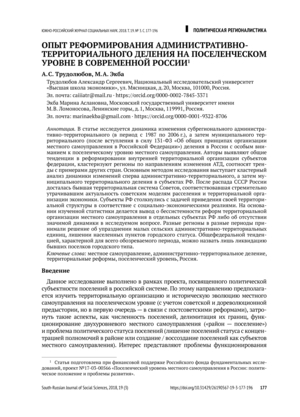Аннотация
В статье исследуется динамика изменения субрегионального административно-территориального (в период с 1987 по 2006 г.), а затем муниципального территориального (после вступления в силу 131-ФЗ «Об общих принципах организации местного самоуправления в Российской Федерации») деления в России с особым вниманием к поселенческому уровню местного самоуправления. Авторы выявляют общие тенденции в реформировании внутренней территориальной организации субъектов федерации, кластеризуют регионы по направлениям изменения АТД, соотносят тренды с примерами других стран. Основным методом исследования выступает кластерный анализ динамики изменений сперва административно-территориального, а затем муниципального территориального деления в субъектах РФ. После распада СССР России досталась бывшая территориальная система Cоветов, соответствовавшая стремительно утрачивавшим актуальность советским моделям расселения и территориальной организации экономики. Субъекты РФ столкнулись с задачей приведения своей территориальной структуры в соответствие с социально-экономическими реалиями. На основании изученной статистики делается вывод о бессистемности реформ территориальной организации местного самоуправления в отдельных субъектах РФ либо об отсутствии значимой динамики в исследуемом вопросе. Разные регионы в разные периоды принимали решение об упразднении малых сельских административно-территориальных единиц, лишении населенных пунктов городского статуса. Общефедеральной тенденцией, характерной для всего обозреваемого периода, можно назвать лишь ликвидацию бывших поселков городского типа.
Ключевые слова
Информация о финансировании
Статья подготовлена при финансовой поддержке Российского фонда фундаментальных исследований, проект №17-03-00566 «Поселенческий уровень местного самоуправления в России: политическое положение и проблемы развития».
Библиографические ссылки
Charbit, C., & Michalun, M. (2009). Mind the gaps: Managing Mutual Dependence in Relations among Levels of Government. OECD Working Papers on Public Governance, 14, OECD Publishing. DOI:10.1787/221253707200
Chirkin, V. E. (2014). Publichnoe upravlenie “na mestakh”: nekotorye voprosy rossijskogo i zarubezhnogo opyta [Local Public Governance: Some Aspects of the Russian and Foreign Experience]. Zhurnal rossijskogo prava [Journal of Russian Law], 10, 39–48. DOI: 10.12737/5773.
Chislennost’ naseleniya Rossijskoj Federacii po municipal’nym obrazovaniyam. Federalnaya sluzhba gosudarstvennoj statistiki. (2018). [Population numbers of the Russian Federation in Municipal Localities. Government Statistics Office]. Retrieved from http://www.gks.ru/wps/wcm/connect/rosstat_main/rosstat/ru/statistics/publications/catalog/afc8ea004d56a39ab251f2bafc3a6fce
Dergachev V., & Makutina, M. Gosduma v uskorennom rezhime rassmotrit popravki o likvidacii poselenij [The State Duma will Expeditiously Review the Amendments on the Liquidation of Localities]. (2017, March 10). RBK. Retrieved from http://www.rbc.ru/politics/10/03/2017/58c29f429a7947596181c66d
Drobotenko, I. I. (2010). Zarubezhnye modeli mestnogo samoupravleniya: opyt dlya Rossii [Foreign models of Local Selfgovernment: Experience for Russia]. Vlast’ [Power], 1, 119–122.
Eksperty KGI sravnili praktiku municipal’nyh territorial’nyh preobrazovanij v Rossii i Evrope [Committee of Civil Initiatives experts’ Report on Comparative Experiences of Territorial Reforms in Russia and Europe]. Retrieved from https://komitetgi.ru/news/news/3452/
Klejmenov, S. P. (2012). Administrativnyj i ehkonomicheskij faktory prostranstvennogo razvitiya Pskovskoj oblasti: istoriya i sovremennost [Administrative and Economic Factors of Pskov Region Spatial Development: The Past and The Present]. Pskovskij regionologicheskij zhurnal [Pskov Regional Studies Magazine], 14, 187–200.
Markvart, Eh., & Johen, F. (2017). Territorialnoe reformirovanie mestnogo samoupravleniya v Germanii i Rossii na sovremennom etape [Present-day territorial reforms of local selfgovernment in Germany and Russia]. Prostranstvennaya ehkonomika [Territorial economy], 3, 40–61. DOI: 10.14530/se.2017.3.040–061.
Multi-level Governance: overview of OECD Country experience. (2017). OECD Multi-level Governance Studies. Retrieved from https://doi.org/10.1787/9789264272866-en
Parishes Names and Codes in England and Wales (2016). Office for National Statistics. Retrieved from http://geoportal.statistics.gov.uk/datasets/parishes-december-2016-names-and-codes-in-england-and-wales
Population by the 2017 administrative reform (2017). Statistics Estonia. Retrieved from http://www.stat.ee/sdb-update?db_update_id=20303
Postanovlenie CK VKP (b) o likvidacii okrugov ot 15 iyulya 1930 g. (1930). [Resolution of the Central Committee of the All-Union Communist Party (Bolsheviks) on the Annulment of Districts as of July 15, 1930]. Retrieved from http://istmat.info/node/48987
Tarkhov, S. A. (2005). Izmenenie administrativno-territorial’nogo deleniya Rossii v XIII–XX vv. Prostranstvennaya organizaciya hozyajstva: TPK ili klastery? [Russian Administrative Division Development in the XII–XX c. Structure of Territorial Economy: Commercial and Industrial Complex or Clusters]. Moscow: IG RAN.
Tranin, A. A. (1984). O ponyatii administrativno-territorial’noj organizacii kapitalisticheskogo gosudarstva [About the Definition of the Administrative Division of a Capitalist State]. In G. V. Barabashev (Ed.) Administrativno-territorialnaya organizaciya kapitalisticheskogo gosudarstva [Administrative Division in a Capitalist State]. (pp. 8–14). Moscow: Nauka.
Turovskij, R. F. (2006). Centr i regiony: problemy politicheskih otnoshenij [Center and the Regions: Problems of Political Relations]. Moscow: HSE Publishing House.
Zakon Rossijskoj Federacii “Ob obshchih principah organizacii mestnogo samoupravleniya v Rossijskoj Federacii” ot 28.08.1995 № 154-FZ. (1995). [Law of the Russian Federation “On Common Principles of the Structure of Local Government in the Russian Federation from 28.08.1995 № 154-FZ”]. Retrieved from http://www.consultant.ru/document/cons_doc_LAW_7642/
Zakon Rossijskoj Federacii “Ob obshchih principah organizacii mestnogo samoupravleniya v Rossijskoj Federacii” ot 06.10.2003 № 131-FZ. (2003). [Law of the Russian Federation “On Common Principles of the Structure of Local Government in the Russian Federation” from 06.10.2003 № 131-FZ]. Retrieved from http://www.consultant.ru/document/cons_doc_LAW_44571/
Zakon Rossijskoj Federacii “Zakon o mestnom samoupravlenii v Rossijskoj federacii” ot 06.07.1991 № 1550-1. (1991). [Law of the Russian Federation “Law on Local Government in the Russian Federation” from 06.07.1991 № 1550–1]. Retrieved from http://www.consultant.ru/document/cons_doc_LAW_105/
Zakon SSSR “Ob obshchikh nachalakh mestnogo samoupravleniya i mestnogo hozyajstva v SSSR” ot 09.04.1990 № N1418-1. (1990). [USSR Law “On Common Principles of Local Government and Local Economy in the USSR” from 09.04.1990 № N1418–1]. Retrieved from http://www.zaki.ru/pagesnew.php?id=1687


